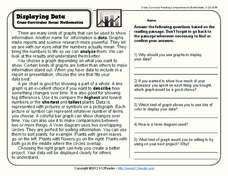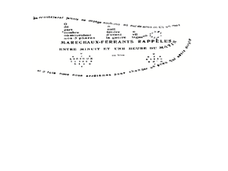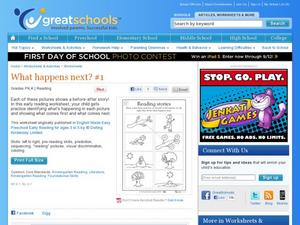Curated OER
A Fair Trade
Students examine a piece of art to find objects and symbols used by the artist. In this visual art lesson, students look at Jaun Quick-to-See Smith's, "Trade Canoe for Don Quixote." They look for symbols and items that show the artists...
Curated OER
I Pledge Allegiance
What does showing respect look like? What behaviors show disrespect? After modeling such behaviors, primary graders create a flag that they hold up while demonstrating respectful behavior as they recite the Pledge of Allegiance. The...
K12 Reader
Displaying Data
It's important to learn how to display data to make the information easier for people to understand. A reading activity prompts kids to use context clues to answer five comprehension questions after reading several paragraphs about...
Curated OER
Mirror Exercise
Kids get up and act! To promote inventiveness, timing, and clowning, they pair up and act as though they are looking in a mirror. Child A does a move while child B attempts to mimic it as closely as possible. This is a fun activity that...
Curated OER
Roller Coasters: They're Fun, But Are They Safe?
Students survey people to find out what roller coasters they like, conduct Internet research to find information on dangers in amusement parks, contact experts on subject, and write feature that shows pros and cons of coasters.
Curated OER
Feelings
Students describe how they feel in different situations. In this feelings lesson plan, students respond to questions asked by the teacher while reading the book The Way I Feel. They also use mirrors to show look at their own faces while...
San Francisco Symphony
Music and Early Man
Creative projects are great ways to increase interest in topical research. Middle schoolers learning about primitive life styles in the Americas explore the importance of music to hunter gatherers. They research and create musical...
Curated OER
The Branding of America (And Your State)
Students investigate about the origins of some major U.S. brands. They explore local products that stimulate the economy. Students create a map showing where those products originate. Students discover the products that their local area...
Curated OER
Music and Animation: 200 Greatest Pop Culture Icons
Music has been used to convey thoughts, feelings, and the human condition for thousands of years. Your class will analyze several songs hear in the animated classic, "Charlie Brown." They will listen to several jazz pieces from the show,...
Curated OER
Self-Portraits
Eighth graders create self-portrait showing value and emotion, and gather information about color and emotion through different handheld applications.
Curated OER
Picture Perfect Poetry
Do your language arts students love to draw? Use this lesson to reinforce poetic techniques with illustration. After drawing what they think poem would look like with no words, middle and high schoolers work on several different...
Curated OER
2nd grade Reading
Read the story Alexander's Terrible Horrible No Good Very Bad Day to your second grade class. They will either draw a picture of the part of the story that they liked the best or write one sentence about the part that made them laugh....
Curated OER
Stonewall and Beyond: Gay and Lesbian Issues
Help learners understand their own biases and how their perspectives may have been influenced by biased media sources. They keep a journal while viewing videos, exploring websites, and engaging in class discussions related to gay and...
Curated OER
Make a Van Gogh-Style Self-Portrait
Learn by doing! Young artists try their hand at creating their own self-portraits in the style of Vincent van Gogh. This worksheet contains a brief explanation of the essential qualities of van Gogh's art: complementary colors and...
Curated OER
Verbally Speaking
Verbs are the center of attention in this resource. Students discover that a verb shows action, then they consider twenty sentences that each have an action verb. Students must click on one of three words at the bottom of each slide in...
Curated OER
Lesson Plan 6: Introducing the Elements of Plot-Part Two
November is National Novel Writing Month, so if your young authors are embarking on this journey, be sure they understand plot elements. This collaborative lesson fits into the context of the larger NaNoWriMo project; however, the ideas...
Southern Nevada Regional Professional Development Program
“Just a Minute” Focus: Adapting Speech
A little bit complicated, but a whole lot of fun. Show your class an episode of the British television game show Just a Minute. After an explanation of the rules (no repetition, hesitation, or deviation) groups develop topics, based on...
Japan Society
Japanese Architecture for High School Students
Japanese architecture is rich in symbolism and culture. Critical thinkers engage in three activities intended to expose them to the beauty of Japan. They read through the book, Praise of Shadows by Junichiro Tanizaki and watch the...
Houghton Mifflin Harcourt
Nature Walk: English Language Development Lessons (Theme 2)
Walking in nature is the theme of a unit designed to support English language development lessons. Scholars look, write, speak, and move to explore topics such as camping, woodland animals, instruments,...
Read Works
Famous Inventors Alexander Graham Bell: You Rang?
Scholars read a brief informational text about the famous inventor, Alexander Graham Bell and his invention of the telephone, then show what they know by way of eight questions—six multiple choice and two short answer.
Roald Dahl
Matilda - The Platinum-Blond Man
Before reading Chapter Six, "The Platinum-Blond Man" in Matilda, readers preview the illustration of Mrs. Wormwood dropping her plate of food, and think about what may have happened to cause the scene. After reading the chapter, class...
Curated OER
What Happens Next? 1
Knowing how to sequence events means you have to know what happens before and after. Little ones draw a line from four before images to the images that show what happened next. This is a good challenge for your youngest learners.
San Francisco Symphony
Biographical Slideshow
Biographies can be a fun topic for any history project. Learners choose one famous person that lived between 1865 and 1930 to research. They gather information, work on reading comprehension, and use what they find to create slide shows...
PBS
The History of Book Banning in America
Harry Potter, Are You There God? It's Me, Margaret, To Kill a Mockingbird. Kids view a slide show and then discuss the seven banned books featured in the presentation and the reasons why the books may have been banned.























